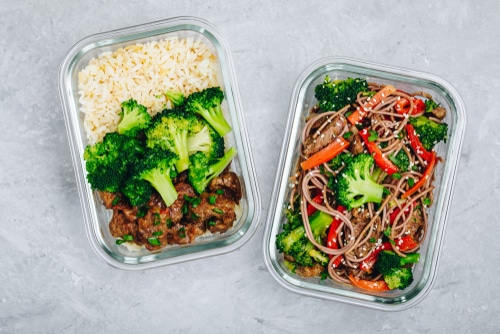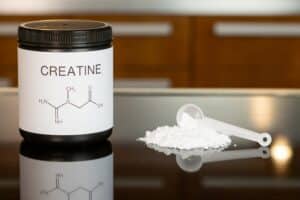Are you more focused on getting out the door on time, and much less on planning ahead what food will fuel your day? Are you wondering how to build a quick meal with all of the key parts to support your training?
Meal prep is a buzzword for anybody wanting to eat healthier and save money. But, there are even more potential wins for athletes (and active individuals!) to meal prep: performance benefits. Meal prepping may also be key to optimizing your training with nutrient timing.
Hi! As a sports dietitian, athlete, wife, and mom of four running my own private practice, meal prep is a part of my weekly routine to fuel my workouts and busy lifestyle.

In this blog, you will learn:
- Why you should meal prep
- Performance {and health} benefits
- The difference between meal prep, meal delivery, and meal kits
- Tools to get started
- How to build meals
- Popular meal delivery & meal kit providers for athletes
Let’s dive in!
Why meal prep?
Meal prep for athletes is not a new concept, but it has gained a lot of popularity, fast-tracked, of course, by social media. This game plan will save you time and money, help make sure you have the right foods ready when you need them, and support performance gains with the right nutrition–for you.
Meal prep will look different for every athlete. Depending on when you find it hardest to focus on fueling, meal prep done well will help you nourish your body and fuel your best performance. Meal prepping might focus on a single meal (let’s say, breakfast) or you might need multiple meals or snacks prepped.
To all athletes–breakfast is not optional (especially if you are a morning exerciser). Consider meal prepping to jumpstart your day whether you train in the morning or later in the day.

Athlete Performance & Health Benefits
Your nutrient (aka food) needs are unique to your physical demands (exercise), performance goals, and more. Preparing meals in advance helps you meet your individual needs–at the right time.
Research supports the benefits of nutrient timing for people who exercise–especially highly trained athletes–on performance and body composition. (1)
The International Society of Sports Nutrition (ISSN) released a position stand in 2017 stating (1):
- Optimized timing of food (especially protein and carbohydrates) may improve recovery and muscle repair, help build muscle, and improve mood after exercise.
- Rather than one big protein-heavy meal, it is better to have smaller amounts of protein every 3 hours.
- Pre- and post-exercise nutrition including carbohydrate + protein or protein alone may help you get stronger and improve body composition.
Spacing your meals out evenly throughout the day {with adequate protein} and the right amounts of carbohydrates and fat helps:
- stabilize your energy level (Avoid those highs and lows…and the afternoon snooze!)
- optimize carbohydrate availability during exercise (2)
- promote muscle recovery
- store less fat
Do you find yourself dragging by 3:00 in the afternoon or having frequent cravings for ‘something sweet’, caffeine or a diet soda pick-me-up?
This may indicate that you are not eating enough food or that your nutrient timing may need to be adjusted. Schedule a consultation to make sure you are meeting your calorie needs with the correct timing. P.S. I’m currently accepting new clients!
Meal prep, meal delivery, and/or meal kits can help you close those gaps and stay performance ready. Next, we’ll discuss the differences to help you determine which may be the best option for you.
Meal Prep vs. Meal Delivery vs. Meal Kits
Let’s go over what the different options are for getting food ready in advance so that you can pick the best solution based on your goals, budget, and time available to actually cook.
First up: meal prep.
Meal Prep
Meal prep is shorthand for meal preparation which is simply the process of planning and preparing meals. (3) You plan your own menu/recipes, purchase the ingredients, prepare the food, and assemble your own meals – in advance.
This is the same as making extra food to have leftovers but taking one more step to put the food into portioned meal-size containers so you can grab them quickly on the go. If you have a full schedule, you have to be able to think quickly when the bases are loaded.
SO many foods can be made ahead of time! Think–pasta bowls, packable burritos, stuffed baked potatoes, stir fry, grilled sandwiches, quesadillas, and more!
Meal prepping your own meals requires more time but may save the most money. It also allows the most customization for your own training needs (calories, protein, and carbohydrates).
{PRO TIP}: Store your food in glass containers to reduce exposure to endocrine-disrupting chemicals found in plastic. (4) FYI–the endocrine system controls how your body breaks down food and uses it for energy–pretty important for athletes! (5)
Stainless steel meal prep containers work best for cold foods because they cannot be microwaved (unless you’re using a portable oven– download your free sports dietitian’s meal prep must haves below to learn more!)
Download Your Free Sports Dietitian’s Meal Prep Must Haves!
PROS: most customized to your individual nutrition needs, least expensive, may reduce exposure to endocrine-disrupting chemicals
CON: most time-consuming
Next up: meal delivery.
Meal Delivery
Meal delivery is a service offered by a company or provider that prepares the pre-portioned individual meals and delivers them to your home or office. (6) Meals arrive refrigerated or frozen and you can usually choose to cook them in the oven or microwave.
Consider meal delivery a modern twist of the classic frozen meal with fresher and less processed ingredients.
Note: Delivered meals are typically packaged in plastic or plastic-lined containers. Thus, it is worth mentioning a potential increased health risk when frequently consuming food from reheated plastic containers. (7) (Remember the importance of the endocrine system?!)
Meals prepped for you usually include nutrition facts. This means that you can easily figure out what you might need to add to fill any gaps in your nutritional goals (as long as you know what you need, of course). For example, if the meal you ordered provides 37 grams of carbohydrates, you can easily add more carbohydrates if more are needed for your current training cycle.
Not sure how much you need? I have you covered! Schedule a consultation and I can help you figure that out.
PROS: no food prep required (other than cooking in the oven or microwave), nutrition facts provided
CONS: more expensive, potential for increased health risk (reheated plastic)
A few of my favorite meal delivery options are:
- Fresh N Lean
- Factor 75
- Territory Foods
- Daily Harvest
- Meal Pro
- Icon Meals
- Trifecta
Note: Many meal delivery options now offer meal kit services too, so some of these offer 2-in-1 options.
Keep reading to learn more about meal kits versus meal delivery!

Meal Kits
Meal kits are similar to meal delivery services–but require more work. Instead of delivering pre-portioned meals, pre-portioned (and sometimes partially prepared) ingredients are provided for a specific recipe that you prepare at home. (8)
Meal kits cost more than purchasing your own ingredients at the grocery store, but save planning and prepping time. If you are an impulsive shopper, this solution may actually save money if you tend to purchase foods that are not on your list…or have little ‘critters’ (aka children) who have a say about what goes in the basket.
If you are preparing for a family or want leftovers, meal kits may be a better option (definitely more budget-friendly) than meal delivery. This service allows you to scale the recipe by choosing the number of people. Ultimately, you still have to portion the foods to maintain the controlled nutrition per serving and to get the number of servings you purchased for.
Nutrition facts are usually provided but will only be accurate if you do not modify the recipe when preparing the meal. Plus, you’ll need to pay attention to (and follow) their suggested portions.
PROS: saves prep time, may save money, nutrition facts provided
CONS: more expensive than purchasing your own ingredients, more time than meal delivery or pickup
Here is a short list of online meal kit options:
- HelloFresh
- Blue Apron
- Home Chef
- Sunbasket
- Purple Carrot (plant-based)
Meal delivery and meal kit services are often offered as subscription models, but there are many emerging options for one-time delivery, drive-thru, and brick and mortar grab-and-go.
Subscriptions are most often available as weekly or monthly recurring, but each provider varies. Frequency also depends if you are purchasing through a local provider or large-scale nationwide franchise.
It is nice to have options, but you have to decide which option is best for you right now. Also, sometimes the best option may change depending on your season of life.
Which is best?
The best option for you depends on your time availability (or willingness to plan), budget, and health or performance goals.
Are you trying to develop a long-term, more budget-friendly habit and learn the art of putting your own meals together specific to your needs?
or…
Are you trying to achieve a short-term goal and “get the job done” with the least amount of effort and less consideration of your pocketbook?
While meal prepping requires the most time, there are tools you can have on hand to make the process go more smoothly.
Tools to Get Started
Other than food storage containers, there are not any special tools required for meal prep. However, some tools may make it a little easier:
- Meal prep containers (preferably glass or stainless steel)
- Meal prep cookbook
- Sheet pan recipes
Meal prep containers are a must-have because that is the purpose–to pack your meals ahead of time so you can grab quickly on the way out the door or even if you work from home.
Otherwise, the food prepared is no different than just having leftovers in your refrigerator and not taking the time to actually put the food together to take with you.
If you search ‘meal prep’ online, the container options are endless. I recommend using caution with the plastic containers on the market, especially if you plan (or at least hope) to make this a long-term new habit to fuel your performance.
PRO TIP: Opt for divided food containers if you like your food separate, or, if you’re like me and like to mix everything together, use individual containers. (Divided containers are perfect for snack meal prep!)
Download Your Free Sport’s Dietitian Meal Prep Must Haves
A meal prep cookbook is not required but can be helpful because they typically outline how to prepare several meals at one time and provide nutrition facts per serving. The Paleo Meal Prep cookbook is one of my favorites because the recipes are simple and taste good (not because I follow a ‘Paleo’ diet).
Sheet pan recipes abound and are helpful for reducing clean-up time. (A win-win in my book!)
The alternative to a meal prep cookbook is cooking your own recipe (maybe in bulk quantities, depending) and dividing the same meal into multiple containers. This method can work for you if you do not mind monotony, but for others who prefer variety, a meal prep cookbook can save a lot of time.
Other than that, meal prep for athletes can literally be as easy as 1, 2, 3:
- Prepare your meals from a new (or old) recipe – or just use leftovers.
- Portion into individual food containers.
- Grab on your way out the door.

Building Meals
Once you find your favorite recipes and understand your personal needs, it is super quick & easy to swap your foods out to create new meals.
You may benefit from consulting with a sports dietitian first if you are unsure of your individual needs. Reminder: Adjust your food intake during different training seasons. Off-season needs are different from in-season performance fueling.
The building blocks of any meal always include:
PROTEIN + CARBOHYDRATE + FAT
Read my blog about putting together simple meals including these three building blocks. Not a teenage athlete? No worries–the same rules apply no matter your age!
Protein should be the first building block of any meal. Including 20-40 grams of protein at each meal every 3 to 4 hours may help improve body composition, support recovery, and performance. (1)
Building Snacks
For a performing athlete, a snack needs to look more like a regular meal. An apple alone is not enough nutrition for an athlete at snack time. An apple with peanut butter and a glass of milk with added protein powder may be a better snack depending on your body size.
Other snack ideas that can be made ahead of time:
- Egg taco with potatoes and cheese
- Boiled eggs with fresh fruit and pretzels
- Peanut butter sandwich with sliced banana and pint of milk
- Whole grain sandwich made with sliced boiled eggs and avocado and a side of salted watermelon
PRO TIP: Pack snacks in brown bags and store in the refrigerator–or by the back door–so they are ready to go!

That’s a wrap!
Beyond convenience, meal prep for athletes offers performance benefits supporting nutrient timing to recover better and fuel exercise.
Schedule a consultation to determine your nutrient timing needs and to discuss if meal prepping is a good option for you. We will make a plan to help you increase energy and support your best performance!







